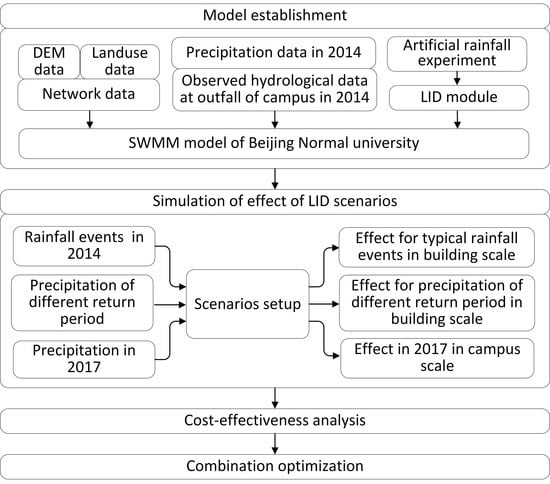Detailed Quantification of the Reduction Effect of Roof Runoff by Low Impact Development Practices
Abstract
1. Introduction
2. Materials and Methods
2.1. Study Area
2.2. SWMM Description
2.3. Source of Data and Model Setup
2.4. Scenario Setting
2.5. Assessment and Optimization Methods
2.5.1. Effect Indicators
2.5.2. Design Storm of Different Return Periods
2.5.3. Cost-Effectiveness Analysis
2.5.4. Optimization Algorithm
3. Results and Discussion
3.1. Results of Model Performance
3.2. Reduction Effect of Individual and Combined LID Practices for Typical Rainfall Events in 2014
3.3. Reduction Effect of Individual and Combined Lid Practices for Precipitation of Different Return Periods
3.4. Cost-Effectiveness Analysis for Annual Continuous Simulation
3.5. Reduction Effect at Campus Scale
4. Conclusions
Supplementary Materials
Author Contributions
Funding
Acknowledgments
Conflicts of Interest
References
- Muis, S.; Güneralp, B.; Jongman, B.; Aerts, J.C.; Ward, P.J. Flood risk and adaptation strategies under climate change and urban expansion: A probabilistic analysis using global data. Sci. Total Environ. 2015, 538, 445–457. [Google Scholar] [CrossRef]
- Miller, J.D.; Hutchins, M. The impacts of urbanisation and climate change on urban flooding and urban water quality: A review of the evidence concerning the United Kingdom. J. Hydrol. Reg. Stud. 2017, 12, 345–362. [Google Scholar] [CrossRef]
- Zhou, Q.; Leng, G.; Su, J.; Ren, Y. Comparison of urbanization and climate change impacts on urban flood volumes: Importance of urban planning and drainage adaptation. Sci. Total Environ. 2019, 658, 24–33. [Google Scholar] [CrossRef] [PubMed]
- Paprotny, D.; Sebastian, A.; Morales-Nápoles, O.; Jonkman, S.N. Trends in flood losses in Europe over the past 150 years. Nat. Commun. 2018, 9, 1985. [Google Scholar] [CrossRef] [PubMed]
- Zhang, X.; Sheng, W.; Qi, S. Hazards and reflection on Fangshan District extreme rainstorm of 21 July 2012, the urban mountainous region of Beijing, North China. Nat. Hazards 2018, 94, 1459–1461. [Google Scholar] [CrossRef]
- Dietz, M.E. Low impact development practices: A review of current research and recommendations for future directions. Water Air Soil Pollut. 2007, 186, 351–363. [Google Scholar] [CrossRef]
- MHURD. Technical Guide for Sponge Cities-Construction of Low Impact Development (for Trial Implementation); Development, M.O.H.A.U.R., Ed.; Ministry of Housing and Urban Rural Development: Beijing, China, 2014. [Google Scholar]
- Ahiablame, L.M.; Engel, B.A.; Chaubey, I. Effectiveness of low impact development practices: Literature review and suggestions for future research. Water Air Soil Pollut. 2012, 223, 4253–4273. [Google Scholar] [CrossRef]
- Redfern, T.W.; Macdonald, N.; Kjeldsen, T.R.; Miller, J.D.; Reynard, N. Current understanding of hydrological processes on common urban surfaces. Prog. Phys. Geogr. 2016, 40, 699–713. [Google Scholar] [CrossRef]
- Hunt, W.; Hathaway, J.; Winston, R.; Jadlocki, S. Runoff volume reduction by a level spreader–vegetated filter strip system in suburban Charlotte, NC. J. Hydrol. Eng. 2010, 15, 499–503. [Google Scholar] [CrossRef]
- Ahiablame, L.; Shakya, R. Modeling flood reduction effects of low impact development at a watershed scale. J. Environ. Manag. 2016, 171, 81–91. [Google Scholar] [CrossRef]
- Luan, Q.; Fu, X.; Song, C.; Wang, H.; Liu, J.; Wang, Y. Runoff effect evaluation of LID through SWMM in typical mountainous, low-lying urban areas: A case study in China. Water 2017, 9, 439. [Google Scholar] [CrossRef]
- Bai, Y.; Zhao, N.; Zhang, R.; Zeng, X. Storm water management of low impact development in urban areas based on SWMM. Water 2019, 11, 33. [Google Scholar] [CrossRef]
- Shen, Z.-Y.; Chen, L.; Xie, H.; Ma, Y.; Feng, X.; Wei, G.-Y. Low Impact Development on Urban Nonpoint Source Pollution Control: A Review. Geol. Sci. Technol. Inf. 2012, 31, 171–176. [Google Scholar]
- Berndtsson, J.C. Green roof performance towards management of runoff water quantity and quality: A review. Ecol. Eng. 2010, 36, 351–360. [Google Scholar] [CrossRef]
- Purvis, R.A.; Winston, R.J.; Hunt, W.F.; Lipscomb, B.; Narayanaswamy, K.; McDaniel, A.; Lauffer, M.S.; Libes, S. Evaluating the Hydrologic Benefits of a Bioswale in Brunswick County, North Carolina (NC), USA. Water 2019, 11, 1291. [Google Scholar] [CrossRef]
- Silva, M.D.; K Najjar, M.; WA Hammad, A.; Haddad, A.; Vazquez, E. Assessing the Retention Capacity of an Experimental Green Roof Prototype. Water 2020, 12, 90. [Google Scholar] [CrossRef]
- Hilten, R.N.; Lawrence, T.M.; Tollner, E.W. Modeling stormwater runoff from green roofs with HYDRUS-1D. J. Hydrol. 2008, 358, 288–293. [Google Scholar] [CrossRef]
- Brown, R.; Skaggs, R.; Hunt Iii, W. Calibration and validation of DRAINMOD to model bioretention hydrology. J. Hydrol. 2013, 486, 430–442. [Google Scholar] [CrossRef]
- Sun, T.; Bou-Zeid, E.; Wang, Z.-H.; Zerba, E.; Ni, G.-H. Hydrometeorological determinants of green roof performance via a vertically-resolved model for heat and water transport. Build. Environ. 2013, 60, 211–224. [Google Scholar] [CrossRef]
- Peng, Z.; Stovin, V. Independent validation of the SWMM green roof module. J. Hydrol. Eng. 2017, 22, 04017037. [Google Scholar] [CrossRef]
- Cipolla, S.S.; Maglionico, M.; Stojkov, I. A long-term hydrological modelling of an extensive green roof by means of SWMM. Ecol. Eng. 2016, 95, 876–887. [Google Scholar] [CrossRef]
- Krebs, G.; Kuoppamäki, K.; Kokkonen, T.; Koivusalo, H. Simulation of green roof test bed runoff. Hydrol. Process. 2016, 30, 250–262. [Google Scholar] [CrossRef]
- Li, J.; Li, Y.; Li, Y. SWMM-based evaluation of the effect of rain gardens on urbanized areas. Environ. Earth Sci. 2016, 75, 17. [Google Scholar] [CrossRef]
- Gülbaz, S.; Kazezyılmaz-Alhan, C.M. An evaluation of hydrologic modeling performance of EPA SWMM for bioretention. Water Sci. Technol. 2017, 76, 3035–3043. [Google Scholar] [CrossRef] [PubMed]
- Palla, A.; Gnecco, I. Hydrologic modeling of Low Impact Development systems at the urban catchment scale. J. Hydrol. 2015, 528, 361–368. [Google Scholar] [CrossRef]
- Babaei, S.; Ghazavi, R.; Erfanian, M. Urban flood simulation and prioritization of critical urban sub-catchments using SWMM model and PROMETHEE II approach. Phys. Chem. Earth Parts A/B/C 2018, 105, 3–11. [Google Scholar] [CrossRef]
- Randall, M.; Sun, F.; Zhang, Y.; Jensen, M.B. Evaluating Sponge City volume capture ratio at the catchment scale using SWMM. J. Environ. Manag. 2019, 246, 745–757. [Google Scholar] [CrossRef]
- Tuomela, C.; Sillanpää, N.; Koivusalo, H. Assessment of stormwater pollutant loads and source area contributions with storm water management model (SWMM). J. Environ. Manag. 2019, 233, 719–727. [Google Scholar] [CrossRef]
- Niazi, M.; Nietch, C.; Maghrebi, M.; Jackson, N.; Bennett, B.R.; Tryby, M.; Massoudieh, A. Storm water management model: Performance review and gap analysis. J. Sustain. Water Built Environ. 2017, 3, 04017002. [Google Scholar] [CrossRef]
- Minh, H.D. Optimal Planning of Low-Impact Development for TSS Control in the Upper Area of the Cau Bay River Basin, Vietnam. Water 2020, 12, 533. [Google Scholar] [CrossRef]
- Pereira, S.F.; Leite, C.M.E.; Koide, S. Hydrological Modelling and Evaluation of Detention Ponds to Improve Urban Drainage System and Water Quality. Water 2019, 11, 1547. [Google Scholar] [CrossRef]
- Xie, H.; Wu, Y.; Wang, L.; Luo, W.; Zhou, W.; Zhou, H.; Yan, Y.; Liu, J. Comparing simulations of green roof hydrological processes by SWMM and HYDRUS-1D. Water Supply 2019. [Google Scholar] [CrossRef]
- Palermo, S.A.; Turco, M.; Principato, F.; Piro, P. Hydrological effectiveness of an extensive green roof in Mediterranean climate. Water 2019, 11, 1378. [Google Scholar] [CrossRef]
- Stovin, V.; Vesuviano, G.; Kasmin, H. The hydrological performance of a green roof test bed under UK climatic conditions. J. Hydrol. 2012, 414, 148–161. [Google Scholar] [CrossRef]
- Voyde, E.; Fassman, E.; Simcock, R. Hydrology of an extensive living roof under sub-tropical climate conditions in Auckland, New Zealand. J. Hydrol. 2010, 394, 384–395. [Google Scholar] [CrossRef]
- BMBLF. Specification for Roof Greening; Beijing Municipal Bureau of Landscape and Forestry: Beijing, China, 2015; Volume DB11/T 281-2015. [Google Scholar]
- Deletic, A.; Fletcher, T.D. Performance of grass filters used for stormwater treatment—A field and modelling study. J. Hydrol. 2006, 317, 261–275. [Google Scholar] [CrossRef]
- Price, K.; Jackson, C.R.; Parker, A.J. Variation of surficial soil hydraulic properties across land uses in the southern Blue Ridge Mountains, North Carolina, USA. J. Hydrol. 2010, 383, 256–268. [Google Scholar] [CrossRef]
- Rosa, D.J.; Clausen, J.C.; Dietz, M.E. Calibration and verification of SWMM for low impact development. JAWRA J. Am. Water Resour. Assoc. 2015, 51, 746–757. [Google Scholar] [CrossRef]
- Hou, X.; Chen, L.; Liu, X.; Li, M.; Shen, Z. Parameter transferability across spatial resolutions in urban hydrological modelling: A case study in Beijing, China. Front. Earth Sci. 2019, 13, 18–32. [Google Scholar] [CrossRef]
- Jia, H.; Yao, H.; Tang, Y.; Shaw, L.Y.; Field, R.; Tafuri, A.N. LID-BMPs planning for urban runoff control and the case study in China. J. Environ. Manag. 2015, 149, 65–76. [Google Scholar] [CrossRef]
- Guo, X.; Guo, Q.; Zhou, Z.; Du, P.; Zhao, D. Degrees of hydrologic restoration by low impact development practices under different runoff volume capture goals. J. Hydrol. 2019, 578, 124069. [Google Scholar] [CrossRef]
- Zhu, Z.; Chen, Z.; Chen, X.; Yu, G. An assessment of the hydrologic effectiveness of low impact development (LID) practices for managing runoff with different objectives. J. Environ. Manag. 2019, 231, 504–514. [Google Scholar] [CrossRef] [PubMed]
- Keifer, C.J.; Chu, H.H. Synthetic storm pattern for drainage design. J. Hydraul. Div. 1957, 83, 1–25. [Google Scholar]
- Wang, Q.; Zhang, X.; Wei, M.; Zhou, Y.; Li, P.; Bai, G. Research summary of planning and design standards for storm water system in Beijing City. Water Wastewater Eng. 2011, 10. [Google Scholar] [CrossRef]
- Yao, L.; Wei, W.; Chen, L. How does imperviousness impact the urban rainfall-runoff process under various storm cases? Ecol. Indic. 2016, 60, 893–905. [Google Scholar] [CrossRef]
- Mei, C.; Liu, J.; Wang, H.; Yang, Z.; Ding, X.; Shao, W. Integrated assessments of green infrastructure for flood mitigation to support robust decision-making for sponge city construction in an urbanized watershed. Sci. Total Environ. 2018, 639, 1394–1407. [Google Scholar] [CrossRef] [PubMed]
- Deb, K.; Pratap, A.; Agarwal, S.; Meyarivan, T. A fast and elitist multiobjective genetic algorithm: NSGA-II. IEEE Trans. Evol. Comput. 2002, 6, 182–197. [Google Scholar] [CrossRef]
- Xu, T.; Jia, H.; Wang, Z.; Mao, X.; Xu, C. SWMM-based methodology for block-scale LID-BMPs planning based on site-scale multi-objective optimization: A case study in Tianjin. Front. Environ. Sci. Eng. 2017, 11, 1. [Google Scholar] [CrossRef]
- Jeon, D.J.; Ki, S.J.; Cha, Y.; Park, Y.; Kim, J.H. New methodology of evaluation of best management practices performances for an agricultural watershed according to the climate change scenarios: A hybrid use of deterministic and decision support models. Ecol. Eng. 2018, 119, 73–83. [Google Scholar] [CrossRef]
- Geng, R.; Yin, P.; Sharpley, A.N. A coupled model system to optimize the best management practices for nonpoint source pollution control. J. Clean. Prod. 2019, 220, 581–592. [Google Scholar] [CrossRef]
- Shafique, M.; Kim, R.; Rafiq, M. Green roof benefits, opportunities and challenges–A review. Renew. Sustain. Energy Rev. 2018, 90, 757–773. [Google Scholar] [CrossRef]
- Liao, Z.; Chen, H.; Huang, F.; Li, H. Cost–effectiveness analysis on LID measures of a highly urbanized area. Desalin. Water Treat. 2015, 56, 2817–2823. [Google Scholar] [CrossRef]
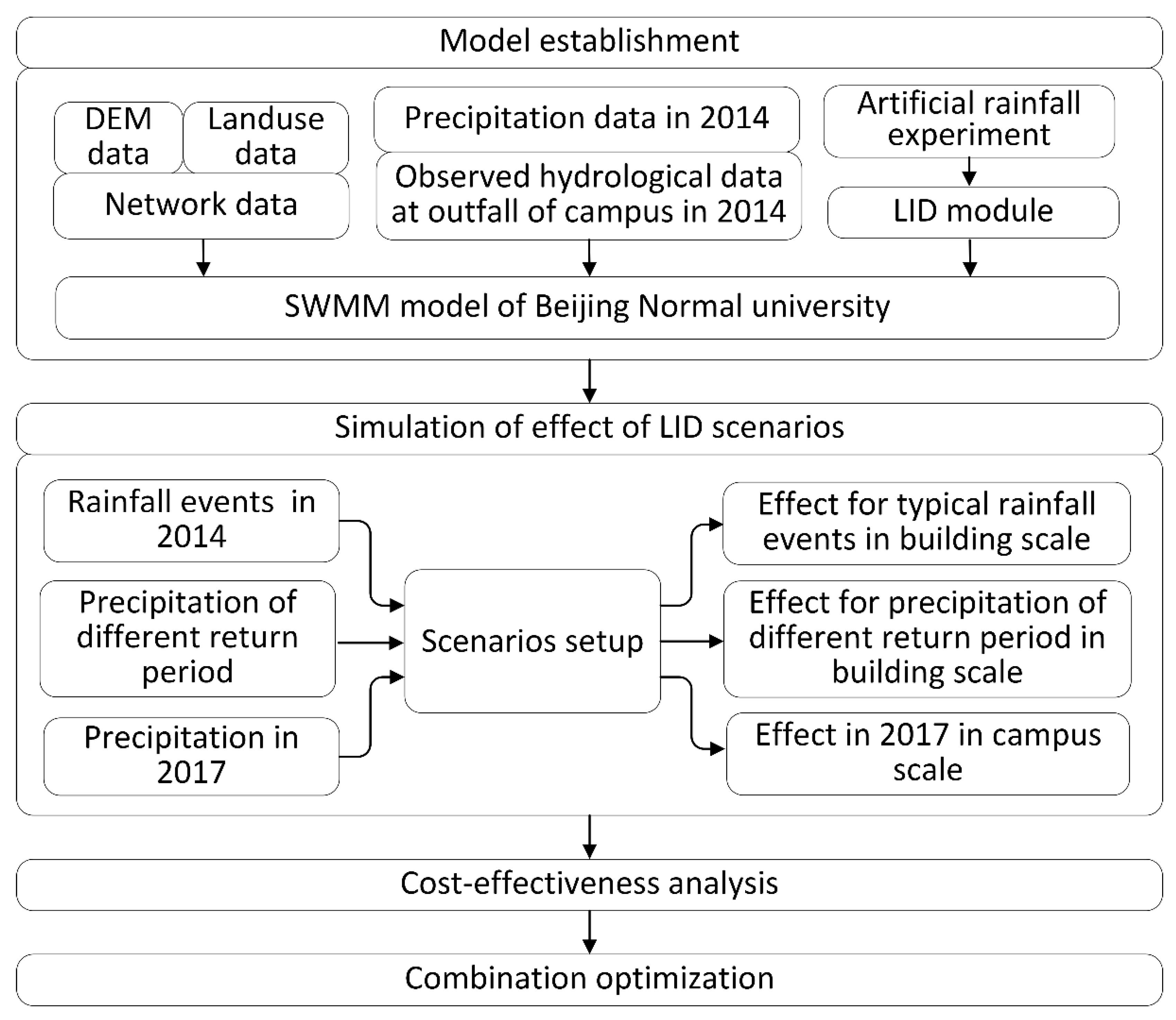


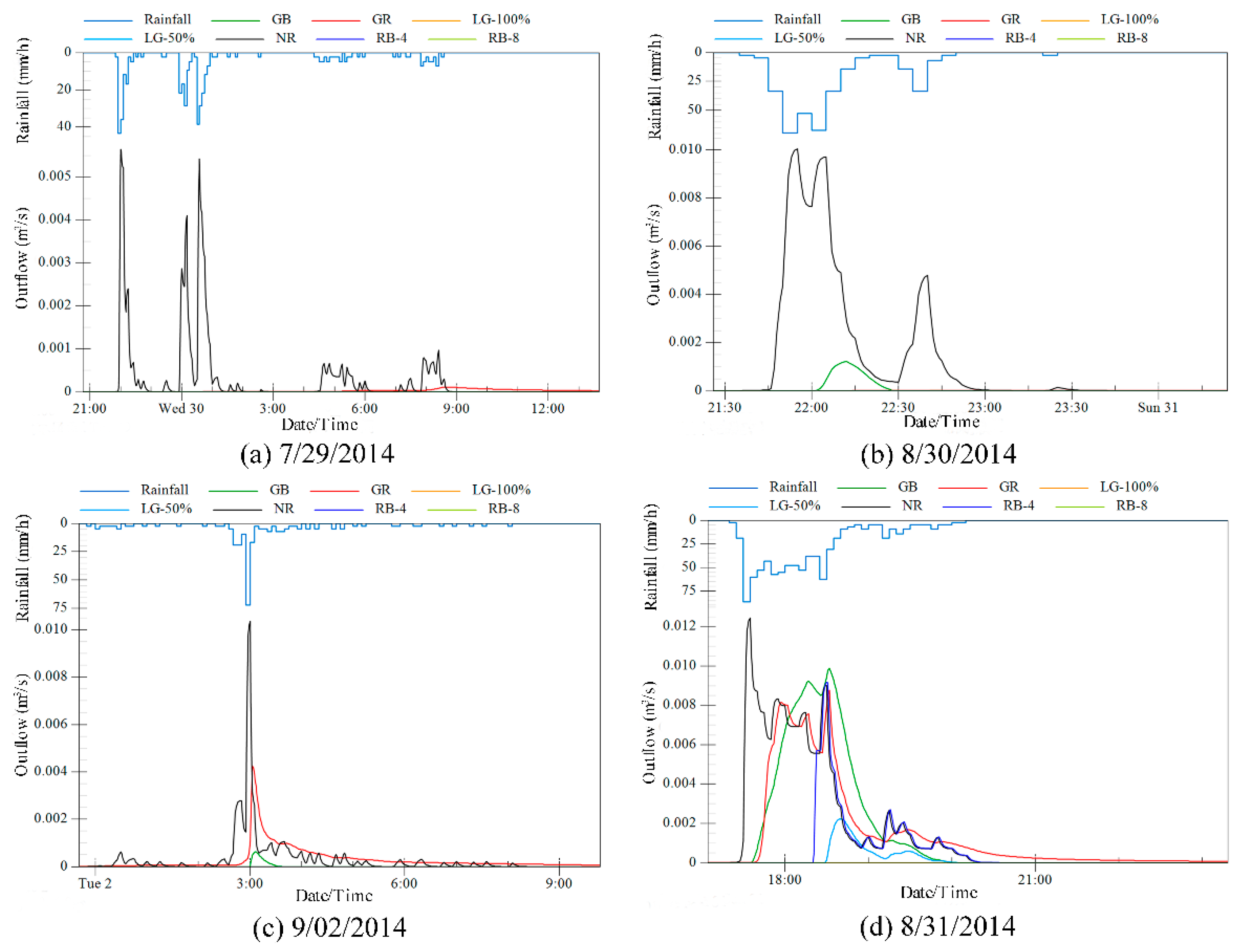
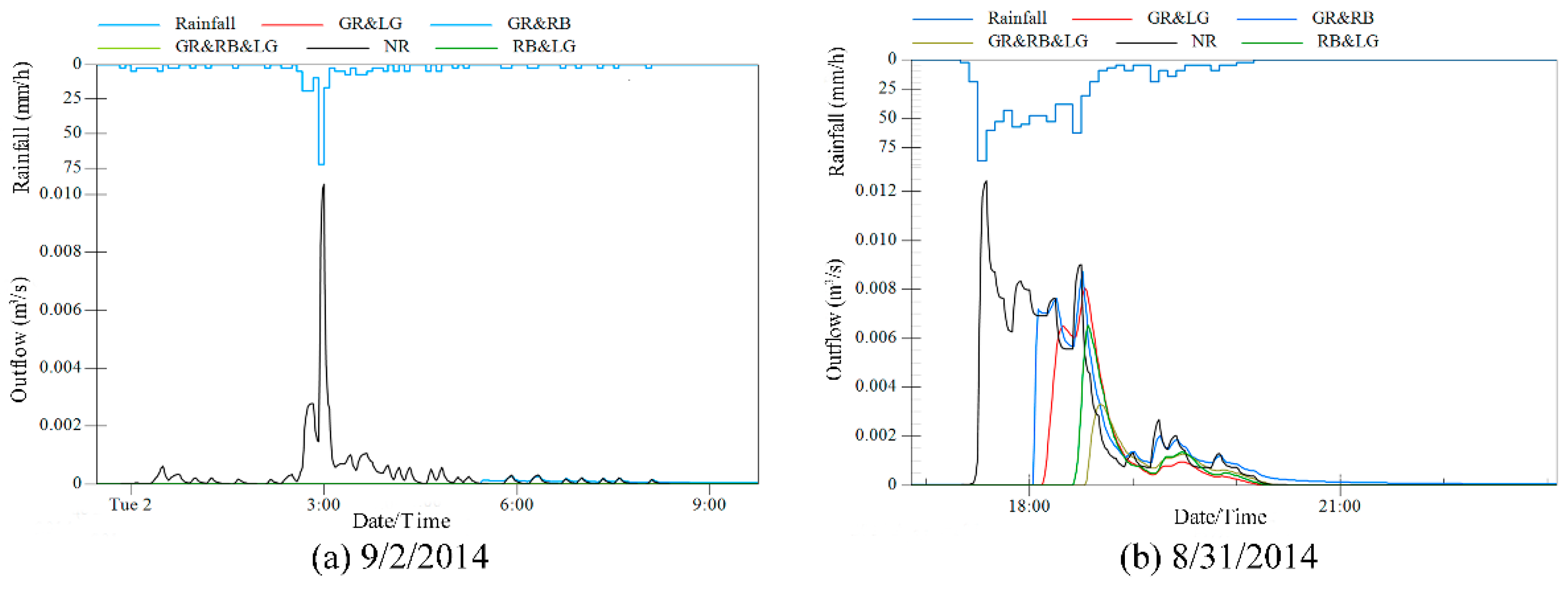
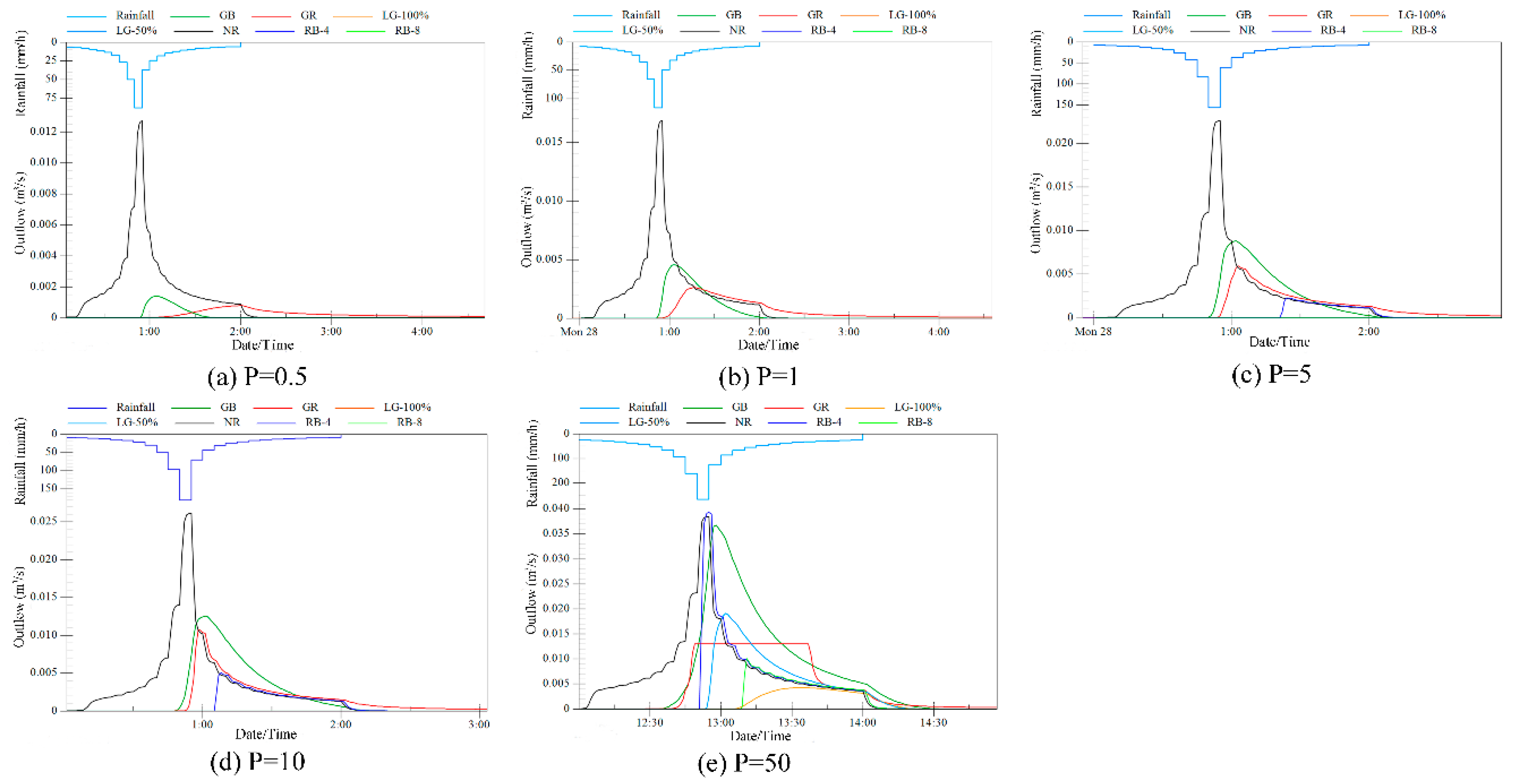
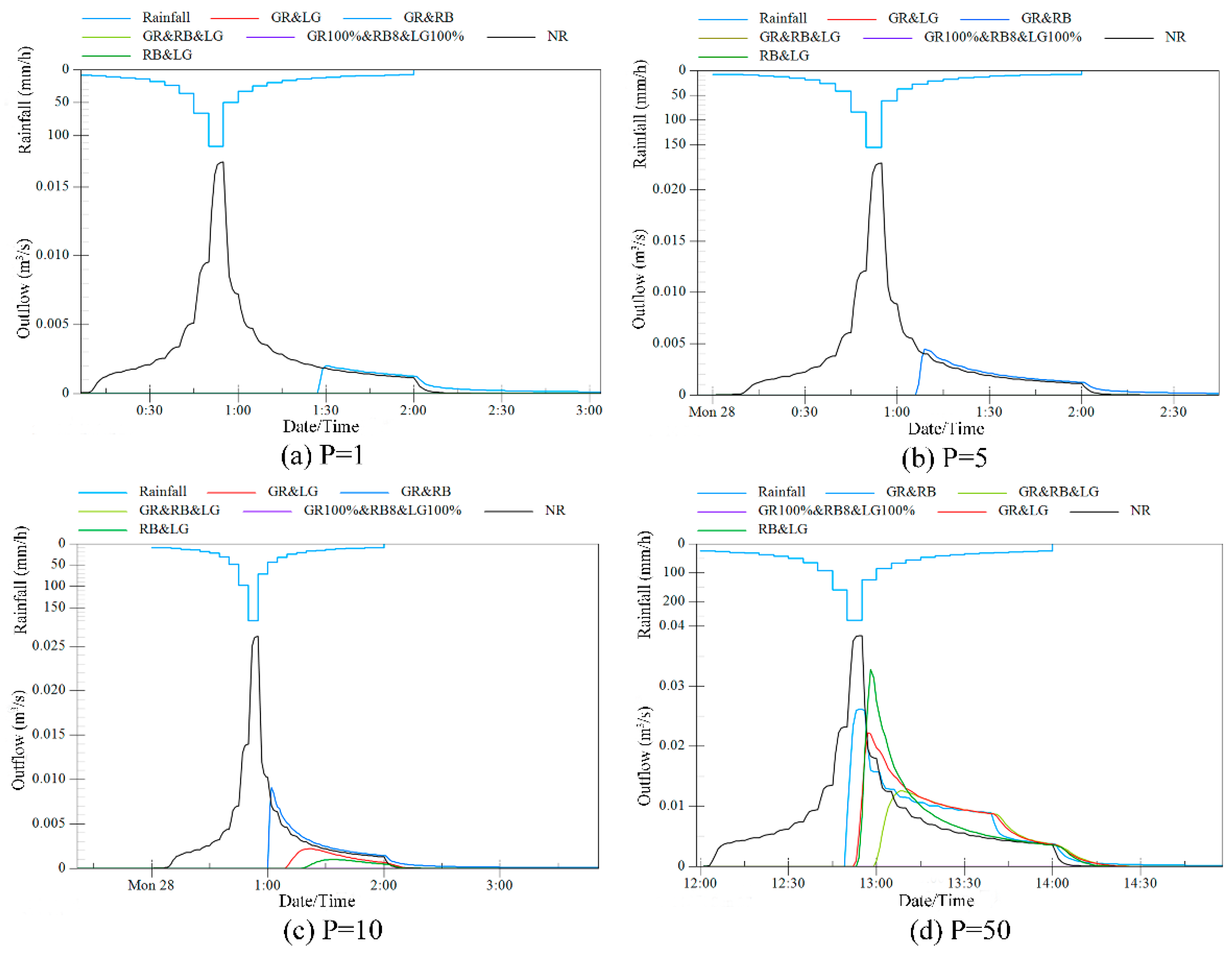
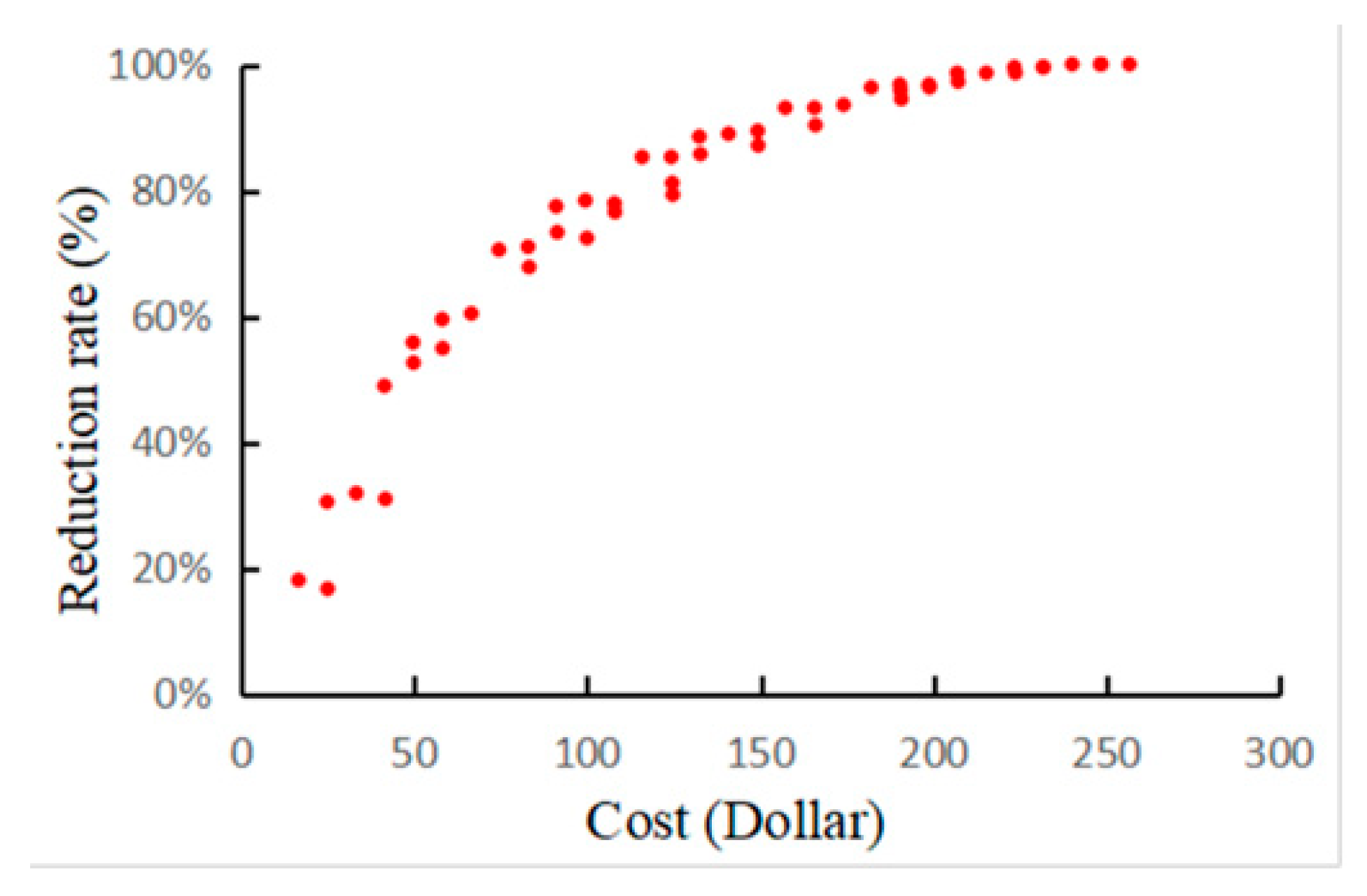
| Date (mm-dd-y) | Rainfall Depth (mm) | Rainfall Duration (min) | Average Intensity (mm/h) | Peak Intensity (mm/h) | Antecedent Dry Days (d) | Rainfall Type |
|---|---|---|---|---|---|---|
| 07-29-2014 | 35.7 | 400 | 5.36 | 43.28 | 5.6 | Large |
| 08-04-2014 | 5.9 | 260 | 1.36 | 9.45 | 4.9 | Light |
| 08-09-2014 | 7.2 | 120 | 3.60 | 24.08 | 2.3 | Light |
| 08-23-2014 | 10.4 | 45 | 13.87 | 38.4 | 2.8 | Medium |
| 08-30-2014 | 29 | 105 | 16.57 | 69.6 | 6.9 | Large |
| 08-31-2014 | 70.76 | 165 | 25.73 | 86.2 | 0.7 | Storm |
| 09-02-2014 | 33.6 | 1880 | 1.07 | 72 | 0.6 | Large |
| 09-26-2014 | 7.8 | 20 | 23.40 | 50.4 | 2.62 | Medium |
| LID | Berm Height (mm) | Soil Thickness (mm) | Porosity | Field Capacity | Wilting Point | Conductivity (mm/h) | Conductivity Slope | Suction Head (mm) | Initially, Saturated (%) |
|---|---|---|---|---|---|---|---|---|---|
| Green roof | 20 | 100 | 0.5 | 0.3 | 0.078 | 90 | 50 | 88.9 | 20 |
| Green belt | 10 | 1000 | 0.453 | 0.19 | 0.085 | 20 | 40 | 90 | 23.2 |
| Scale | Type | Scenarios | Combination of LID and Areas (m2) | Total Area (m2) | |||
|---|---|---|---|---|---|---|---|
| GR | GB | RB | LG | ||||
| Building | Base | NR | |||||
| Individual | GR | 520 | 520 | ||||
| GB | 520 | 520 | |||||
| RB-4 | 12 | 12 | |||||
| RB-8 | 24 | 24 | |||||
| 25%LG | 130 | 130 | |||||
| 50%LG | 260 | 260 | |||||
| 100%LG | 520 | 520 | |||||
| Combined | GR&RB | 260 | 6 | 266 | |||
| GR&LG | 260 | 130 | 390 | ||||
| RB&LG | 6 | 130 | 136 | ||||
| GR&RB&LG | 260 | 6 | 130 | 396 | |||
| GR100%&RB&LG100% | 520 | 24 | 520 | 1064 | |||
| Campus | Base | NR | |||||
| Individual | GR | 105,983 | 105,983 | ||||
| GB | 147,043 | 147,043 | |||||
| RB-4 | 2220 | 2220 | |||||
| RB-8 | 4440 | 4440 | |||||
| LG | 147,043 | 147,043 | |||||
| Combined | GR&RB&GB | 105,983 | 147,043 | 2220 | 255,246 | ||
| GR&RB&LG | 105,983 | 2220 | 147,043 | 255,246 | |||
| Process | Rainfall Events | Rain Type | Total Outflow (m3) | Peak Flow Rate (m3/s) | NSE | PBIAS (%) |
|---|---|---|---|---|---|---|
| Calibration | 07-29-2014 | Large | 4740 | 0.54 | 0.842 | −0.65 |
| 08-04-2014 | Little | 490.9 | 0.07 | 0.861 | 2.26 | |
| 08-09-2014 | Little | 499.9 | 0.14 | 0.905 | −9.75 | |
| 08-23-2014 | Medium | 989.4 | 0.50 | 0.899 | −15.96 | |
| Validation | 08-30-2014 | Large | 3159 | 1.02 | 0.907 | −17.97 |
| 08-31-2014 | Storm | 7205 | 0.97 | 0.793 | −9.64 | |
| 09-02-2014 | Large | 4098 | 0.70 | 0.888 | −1.95 | |
| 09-26-2014 | Medium | 783 | 0.40 | 0.840 | −9.4 |
| Rainfall Events | Scenarios | Volume Reduction Amount (m3) | Volume Reduction Rate (%) | Peak Reduction Rate (%) | Delayed Peak Time (H:M) |
|---|---|---|---|---|---|
| 07-29-2014 | GR | 15.19 | 88.94 | 98.03 | 10:42 |
| 08-30-2014 | GR | 14.06 | 97.35 | 99.85 | 1:52 |
| 08-30-2014 | GB | 13.43 | 93.03 | 87.93 | 0:17 |
| 09-02-2014 | GR | 1.01 | 7.12 | 59.00 | 0:03 |
| 09-02-2014 | GB | 13.60 | 96.04 | 93.91 | 0:07 |
| 08-31-2014 | GR | 4.05 | 11.20 | 29.48 | 0:57 |
| 08-31-2014 | GB | 2.80 | 7.74 | 20.51 | 0:57 |
| 08-31-2014 | RB-4 | 23.15 | 64.02 | 26.16 | 0:55 |
| 08-31-2014 | LG-50% | 32.38 | 89.56 | 82.13 | 1:06 |
| Rainfall Events | Scenarios | Volume Reduction Amount (m3) | Volume Reduction Rate (%) | Peak Reduction Rate (%) | Delayed Peak Time(H:M) |
|---|---|---|---|---|---|
| 09-02-2014 | GR&RB | 12.25 | 86.32 | 97.45 | 2:56 |
| 08-31-2014 | GR&RB | 13.59 | 37.58 | 29.75 | 0:56 |
| 08-31-2014 | GR&LG | 20.43 | 56.50 | 35.09 | 0:57 |
| 08-31-2014 | RB&LG | 26.93 | 74.48 | 47.38 | 0:59 |
| 08-31-2014 | GR&RB&LG | 29.18 | 80.70 | 73.37 | 1:06 |
| Return Period | Scenarios | Volume Reduction Amount (m3) | Volume Reduction Rate (%) | Peak Reduction Rate (%) |
|---|---|---|---|---|
| 0.5 | GR | 12.92 | 74.39 | 93.79 |
| GB | 15.38 | 88.56 | 89.13 | |
| 1 | GR | 12.95 | 55.82 | 84.32 |
| GB | 14.85 | 64.01 | 72.89 | |
| 5 | GR | 13.06 | 47.87 | 73.74 |
| GB | 12.12 | 44.43 | 61.02 | |
| RB-4 | 23.36 | 85.62 | 89.84 | |
| 10 | GR | 13.44 | 42.48 | 58.96 |
| GB | 9.77 | 30.88 | 51.88 | |
| RB-4 | 23.26 | 73.52 | 80.56 | |
| 50 | GR | 12.87 | 20.39 | 66.09 |
| GB | −11.34 | −17.97 | 4.42 | |
| RB-4 | 22.54 | 35.71 | −2.26 | |
| RB-8 | 45.07 | 71.40 | 73.74 | |
| LG-50% | 26.27 | 41.62 | 50.27 | |
| LG-100% | 50.90 | 80.64 | 88.93 |
| Return Period | Scenarios | Volume Reduction Amount (m3) | Volume Reduction Rate (%) | Peak Reduction Rate (%) |
|---|---|---|---|---|
| 1 | GR&RB | 18.46 | 79.58% | 88.01% |
| 5 | GR&RB | 18.46 | 67.68% | 80.13% |
| 10 | GR&RB | 18.23 | 57.62% | 65.18% |
| GR&LG | 27.21 | 85.99% | 91.57% | |
| RB&LG | 29.70 | 93.86% | 96.21% | |
| 50 | GR&RB | 17.35 | 27.49% | 31.95% |
| GR&LG | 20.34 | 32.22% | 42.13% | |
| RB&LG | 23.56 | 37.33% | 14.47% | |
| GR&RB&LG | 30.67 | 48.59% | 67.29% |
| Scenarios | Unit Life Cycle Cost ($) | UAAC ($) | AC ($) | Annual Reduced Volume (m3) | Cost- Efficiency (m3/$) |
|---|---|---|---|---|---|
| GR | 317.1 | 15.86 | 8247.20 | 144.94 | 0.02 |
| GB | 31.72 | 1.59 | 826.80 | 207.63 | 0.25 |
| RB-4 | 350.62 | 17.53 | 210.36 | 191.56 | 0.91 |
| RB-8 | 350.62 | 17.53 | 420.72 | 217.20 | 0.52 |
| LG-25% | 31.72 | 1.59 | 206.70 | 214.38 | 1.04 |
| LG-50% | 31.72 | 1.59 | 413.40 | 217.20 | 0.53 |
| GR&RB | - | - | 4228.78 | 180.60 | 0.04 |
| GR&LG | - | - | 4330.30 | 216.33 | 0.05 |
| RB&LG | - | - | 311.88 | 214.34 | 0.69 |
| GR&RB&LG | - | - | 4435.48 | 217.20 | 0.05 |
| Scenarios | Volume Reduction Amount (m3) | Volume Reduction Rate (%) | Volume Capture Ratio of Rainfall (%) | Overflow Volume Reduction Rate (%) | Overflow Time Reduction Rate (%) |
|---|---|---|---|---|---|
| NR | 0 | 0 | 55.99 | 0 | 0 |
| GR | 24345 | 20.50 | 65.01 | 43.67 | 57.29 |
| GB | 30908 | 26.02 | 67.44 | 46.22 | 67.35 |
| LG | 36430 | 30.67 | 69.49 | 89.91 | 85.40 |
| RB-4 | 3238 | 2.73 | 57.19 | 42.87 | 36.57 |
| RB-8 | 5276 | 4.44 | 57.95 | 43.91 | 36.44 |
| GR&RB&GB | 44504 | 37.47 | 72.48 | 77.28 | 79.38 |
| GR&RB&LG | 48887 | 41.16 | 74.11 | 98.89 | 94.10 |
© 2020 by the authors. Licensee MDPI, Basel, Switzerland. This article is an open access article distributed under the terms and conditions of the Creative Commons Attribution (CC BY) license (http://creativecommons.org/licenses/by/4.0/).
Share and Cite
Zhang, P.; Chen, L.; Hou, X.; Wei, G.; Zhang, X.; Shen, Z. Detailed Quantification of the Reduction Effect of Roof Runoff by Low Impact Development Practices. Water 2020, 12, 795. https://doi.org/10.3390/w12030795
Zhang P, Chen L, Hou X, Wei G, Zhang X, Shen Z. Detailed Quantification of the Reduction Effect of Roof Runoff by Low Impact Development Practices. Water. 2020; 12(3):795. https://doi.org/10.3390/w12030795
Chicago/Turabian StyleZhang, Pu, Lei Chen, Xiaoshu Hou, Guoyuan Wei, Xiaoyue Zhang, and Zhenyao Shen. 2020. "Detailed Quantification of the Reduction Effect of Roof Runoff by Low Impact Development Practices" Water 12, no. 3: 795. https://doi.org/10.3390/w12030795
APA StyleZhang, P., Chen, L., Hou, X., Wei, G., Zhang, X., & Shen, Z. (2020). Detailed Quantification of the Reduction Effect of Roof Runoff by Low Impact Development Practices. Water, 12(3), 795. https://doi.org/10.3390/w12030795






